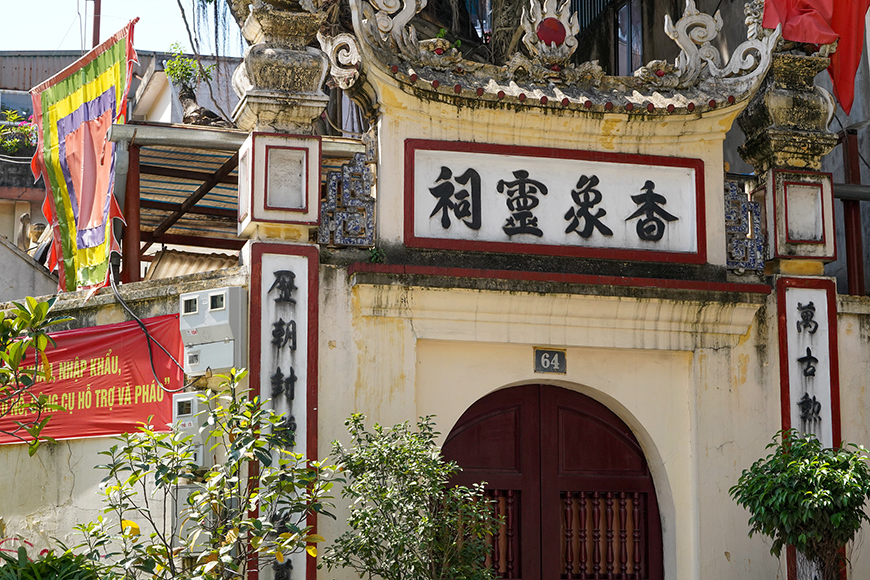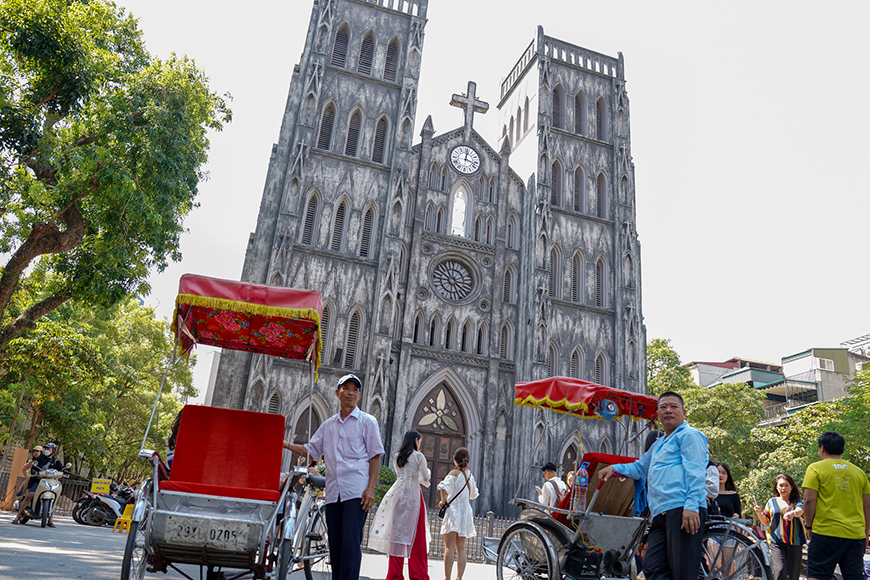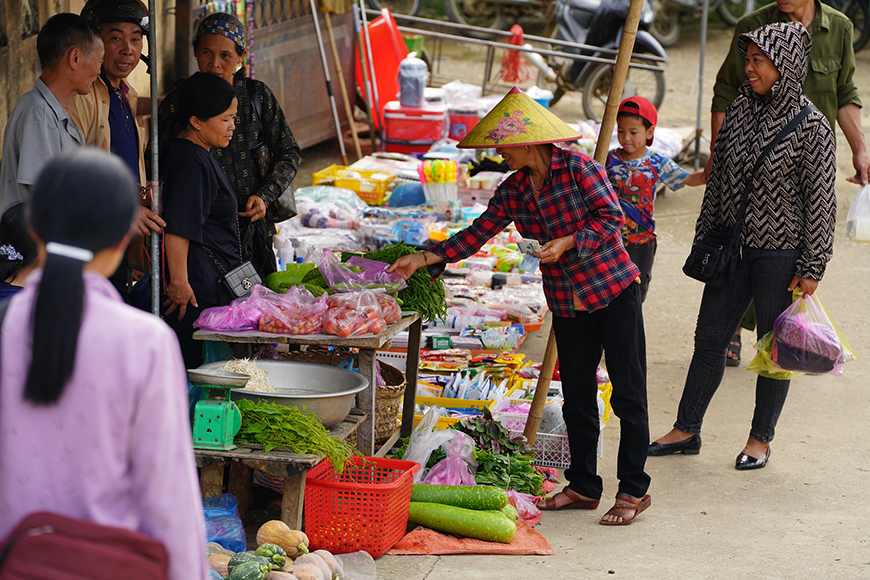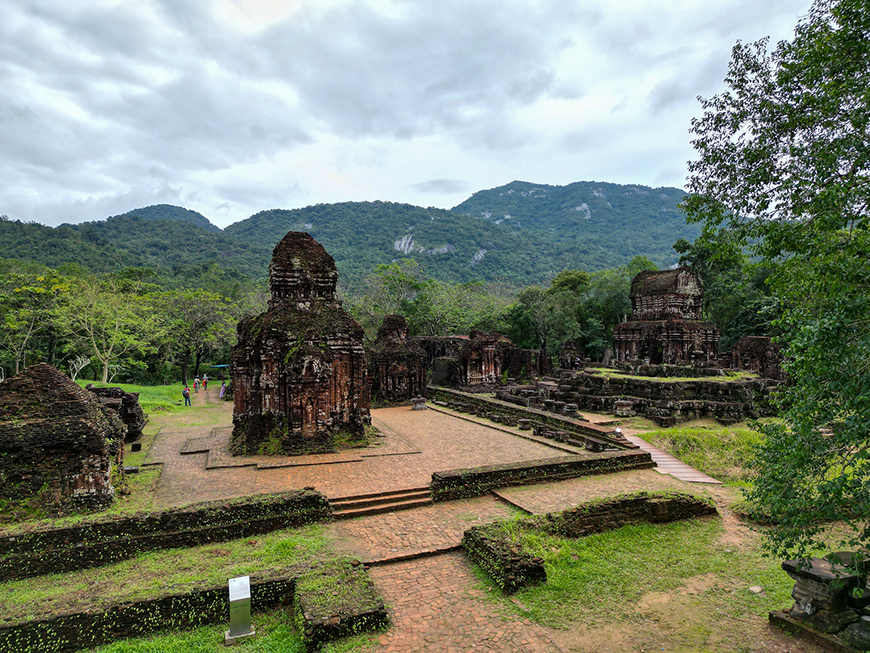Spoken by more than 80% of the population and nearly 4 million Vietnamese abroad, Vietnamese is the official language of Vietnam.
Vietnamese, a unique language
What language is spoken in Vietnam? At first glance, the question can make you smile… Indeed, very logically, the answer is: Vietnamese. But it is true, however, that there may be few doubts… Has Vietnam not been under Chinese tutelage for more than a thousand years? Did not the French colonists remain almost a century? And then, to look at it, Vietnam is the only language in continental Asia to be written using the Latin alphabet (the same one that we use to write English and that you are currently reading this article).
Vietnamese is the official language of Vietnam © Mr Linh's adventure
The Vietnamese language, a tonal language
Historically speaking, the Vietnamese language – which belongs to the Austro-Asian language family (such as Khmer or Cambodian) – had no tonality. It is only through the process of interaction with the Chinese language and especially with the Tai-Kadai language and its highly developed tone system, that Vietnamese language will integrate the tonalite system. Soi is why we say vietnamese is a tonal language. It is generally accepted that the tonalite system appeared around the 6th century – under Chinese domination, therefore – with 3 tones, to evolve to 6 tones under the Ly dynasty. Influenced by several other languages such as Chinese, Muong, Thai, Khmer, Portuguese, French and others, Tiếng Việt – Vietnamese – is nowadays presented as a monosyllabic and tonal language. Note that there are many dialects heard in the 53 ethnic communities that make up the Vietnamese people. For the anecdote, we will report the difference of accent and vocabulary according to the 3 regions of Dragon Land. Thus, in the North we tend to bring out consonants, while in the South, they are very fluid. The Centre is characterized by a way of speaking that some describe as having no vowels available…
The fact remains that the Vietnamese language has 6 tones and 5 accents, that is, when the tone of a word changes, its meaning too. Very few words have more than 2 syllables. In addition, Vietnamese is an isolating language. Grammatical relations are mainly expressed through tool-word systems and in the position of words in sentences. The most used word order in the Vietnamese language is subject - predicate - auxiliary. And finally, the last characteristic of Uncle Ho’s language is its system of personal pronouns, very complex, based on terms designating relationships, kinship, hierarchy by age…
Vietnamese is one of the most widely spoken languages in the world, with nearly 85 million speakers (mainly concentrated in Vietnam, of which it is the mother tongue and official) Abroad, it is spoken by the Vietnamese diaspora, mainly in the States-United, Australia (3rd most spoken language in Kangaroo Country) and France.

Chinese influence in Vietnamese language © Mr Linh's adventure
The Vietnamese language, Chinese influences
From the 2nd century B.C. on, Vietnam was dominated for more than a millennium by the Middle Kingdom.
It goes without saying that this (very) long domination left deep imprints in the culture of Vietnam, imprints still visible today. For example, it is enough to stroll in Hanoi, the capital of the country, to discover the treasures of an architectural heritage in all points remarkable, of which the Temple of Literature - built in 1070 and dedicated to Confucius - is the most impressive representative.
Also, it goes without saying that the Vietnamese language borrowed from Chinese its lot words, sentences, and ways of saying. This resulted in a kind of Sino-Vietnamese - Tiếng Hán - where Chinese was pronounced according to the traditions of Vietnamese phonetics, until it became an integral part of the Vietnamese spoken language. The funny thing about the story is that while these old-fashioned terms are of Chinese origin, the Chinese don’t use them at all. For those who are curious, know that Sino-Vietnamese terms represent about 70% of the vocabulary of the Vietnamese language. They are mainly concentrated in the fields of politics and science, but also in literature (12% presence) and theatre (9%). There are very few in the language spoken on a daily basis. Moreover, there is a tendency to replace Sino-Vietnamese words with purely Vietnamese ones whenever possible.
Of course, before the arrival of Chinese power, the Vietnamese people had their own language, but no official writing. Thus, over the ages, the Han has imposed itself in Vietnam to govern, civilize and educate. This writing system consisted of tens of thousands of ideograms, themselves presented in the form of lines inscribed in a square shape.
In 939, Vietnam finally emerged from the Chinese imperial yoke, slowly reclaiming its own language. The intellectuals of the time set out to develop a new writing system, which, while remaining structured by Chinese ideograms, worked to transcribe the meaning and sound of Vietnamese words. This script is known as Nom. Until the 19th century, the Vietnamese language will be written in Chinese characters (hence the possible confusion to which we alluded at the beginning of the article).

French influence is still visible in Vietnam © Mr Linh's adventure
The language of Vietnam, French influences
At the beginning of the 17th century, the Jesuits, under the leadership of the Catholic congregation of La Compagnie de Jésus, arrived in Vietnam to promote Catholicism. However, missionaries were confronted with the complexity of the Nomavigmnonnais characters, which prevent them from mastering the language. And therefore from evangelizing. Faith moving mountains, they will find the solution by transcribing the sounds they hear in the Latin alphabet. They will thus create a new form of writing - called Quoc ngu - which will be codified and standardized largely by the French priest Alexandre de Rhodes in 1651. In fact, this of Avignon and Jesuit lexicographer only completed the work of his Portuguese comrades Gaspar de Amaral and Antonio Barbosa, but history will retain for posterity only him and his Vietnamese-Latin-Portuguese dictionary (published in Rome in 1651). Thus, compared to Far Eastern languages, Vietnamese is the only language in Southeast Asia that is written using a diacritical Latin alphabet, but with 29 letters including 12 vowels. In theory, if you can read, you are supposed to know how to pronounce the words.
In 1859, the French fleet of the Second Empire, led by a certain Louis-Napoleon Bonaparte - Napoleon III for history books - took occupy of Saigon, a city today known as Ho Chi Minh-city This event will mark the beginning of French domination in Vietnam, a territory then integrated in French Indochina, with Cambodia and Laos.
If Alexandre de Rhodes is considered as the father of Quoc Nu, we will have to wait for the beginning of the year 1861 to see the French authorities introduce this writing in schools. The Nom gradually gave way and, in 1919, the French colonial authorities imposed the Quoc ngu as a national script. Incidentally, this allowed Aboriginal people to be francized… In fact, it was not until 1918 that Emperor Khai Dinh abolished the traditional writing system of Chu Han in the public education system. This led to a redesign of the latter, with in particular the teaching of tiếng Việt as first language and tiếng Pháp (French) as second language.
Anecdotally, the war against the Americans will facilitate some anglicisms, as elsewhere in our globalized civilizations. The Vietnamese language also suffered some Russian influences, especially in the 1990s.

At the market © Mr Linh's adventure
Vietnamese, the main language of Vietnam
While it is true that the
language of Vietnam changes according to its three major regions, it is also accompanied by the dialects spoken by the different ethnic groups that populate the Two Deltas Country. In particular, it identifies:
• The Tieng Hoa (Chinese language), spoken by the
Hoa ethnic group (Chinese), residing mainly in South Vietnam
• The Muong, spoken by the
Muong community, occurs mainly in the mountainous regions of the North, especially in Hoa Binh and Thanh Hoa. Very close to the Vietnamese language, but relieved of its Chinese influence, the muong has the six tones of Vietnamese but uses a modified alphabet with more consonants.
• Tay, a language spoken by
the Tay group, an ethnic community of just under 2 million people, found mostly in northeast Vietnam, bordering China.
• H'Mong, spoken by the Hmong group in the highlands.
• The Nung, spoken by the group of the same name, which mainly populates the northeast of the S-shaped country, near the Chinese border (Cao Bang and Lang Son Provinces).
• Cham, the language of the ancient kingdom of Champa that extended into what is now Central Vietnam, now spoken by the Cham.
• Let’s end with Khmer, the language of the
Mon-Khmer group, a minority community of over a million people, mainly based in the Mekong Delta.
Some of these ethnic groups kept their writing system.
Did you know? Some 100 languages and dialects are spoken in Vietnam, telling the story of a people and a place.

My Son, souvenirs of Cham civilization © Mr Linh's adventure
Vietnamese, a small travel lexicon
It is generally advisable to learn the basic polite words because it is always more friendly (and respectful) to say hello in the language of the country visited! No doubt your efforts to speak Vietnamese will be greatly appreciated with a broad smile, a little amused! Here are some vietnamese vocabulary you may learn and practice :
Hello: Xin chào! (sin chow!)
Goodbye: Tạm biệt (tarm byeet)
Thank you: Cảm ơn bạn (gahm un ban)
You’re welcome: Không có gì (khome co xi)
How are you? = Bạn khỏe không? (ban kwe khome?)
I’m fine, thank you! = Tôi khỏe, cám ơn! (thoy kwe cam on)
Yes: Vâng (vung)
No: Không (khome)
Excuse me: Xin lỗi (seen loy)
Can you help me?: Bạn có thể giúp tôi được không? (ban co teh zoop thoy duc khom?)
Can you speak English?: Bạn có thể nói tiếng Anh không? (ban co teh noy thien an khom)
How much?: Bao nhiêu? (baow nyew)
Too expensive: Quá đắt (qwa dat)
Can you reduce the price?: Bạn có thể giảm giá? (Ban co teh zam za)